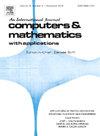广义高阶输沙模型的高阶路径保守中心迎风任意导数(PCCU-ADER)方法
IF 2.5
2区 数学
Q1 MATHEMATICS, APPLIED
引用次数: 0
摘要
本文考虑了Ngatcha和Nkonga(2023)[50]最近发展的泥沙输运理论的扩展和数值近似。该模型考虑了速度波动相关性,以表示经典浅水方程模型中忽略的湍流影响。修正了经典浅水模型在描述泥沙输运现象方面的不足。然而,这一理论没有数值解、数学和物理研究,而且最近的文献也没有提供足够的关于浅水环境下湍流模拟的信息。提出了一种新的二阶路径保守中心迎风任意导数(PCCU-ADER)格式来逼近该模型。所提出的二阶方案具有稳定、收敛、快速、平衡、保持正性和捕获冲击等特点。通过数值和实验验证,与当前文献(如中央迎风方案,基于HLL的黎曼解算器等)中发现的数值方案相比,我们的数值方案的优点得到了证明。研究表明,当水流在陡变地形上移动时,湍流就会出现,并对沉积物的输运现象产生影响。研究结果表明,在这个新的水动力变量下,波前变得过大,改善了浅水方程的经典波前描述。本文章由计算机程序翻译,如有差异,请以英文原文为准。
A high order Path-Conservative Central-Upwind Arbitrary DERivative (PCCU-ADER) method for a generalized high order sediment transport model
An extension and numerical approximation of a sediment transport theory recently developed by Ngatcha and Nkonga (2023) [50] is considered. The model take into account the velocity fluctuation correlations to represent the effect of turbulence neglected in classical models based on shallow water equations. Then the model corrects the deficiency of the classical shallow water modeling in describing sediment transport phenomena. However, no numerical solution, mathematical and physical studies are available for this theory and the recent literature does not provide sufficient information about the turbulence modeling in shallow water context. A new second-order Path-Conservative Central-Upwind Arbitrary DERivative (PCCU-ADER for short) scheme is developed to approximate the model. The proposed second order scheme is proven to be stable, convergent, fast, well-balanced, preserving-positivity and shock-capturing. The benefits of our numerical scheme in comparison to those found in current literature (such as the Central-Upwind scheme, the HLL based Riemann solvers, etc.) are demonstrated through numerical and experimental validations. It has been demonstrated that turbulence emerges when water moves over abrupt topography and exerts an influence on sediment transport phenomena. Our findings indicate with this new hydrodynamic variable, the wavefront becomes too large and improve the classical wavefront description obtained by the shallow water equations.
求助全文
通过发布文献求助,成功后即可免费获取论文全文。
去求助
来源期刊

Computers & Mathematics with Applications
工程技术-计算机:跨学科应用
CiteScore
5.10
自引率
10.30%
发文量
396
审稿时长
9.9 weeks
期刊介绍:
Computers & Mathematics with Applications provides a medium of exchange for those engaged in fields contributing to building successful simulations for science and engineering using Partial Differential Equations (PDEs).
 求助内容:
求助内容: 应助结果提醒方式:
应助结果提醒方式:


